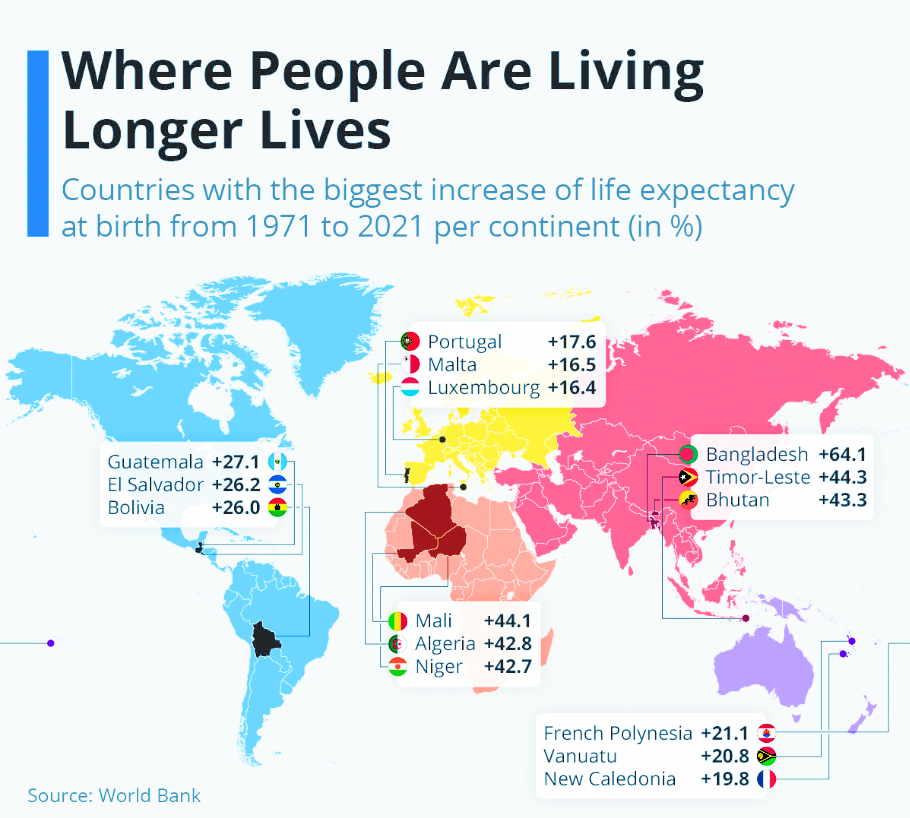Throughout the 20th century, advancements in medical care and rising living standards globally led to a significant surge in life expectancy at birth. Notable gains were observed between 1900 and 1950, excluding the immediate impacts of World War II, thanks to diverse economic and political developments.
Over the past 50 years, a consistent increase in the estimated lifespans of the world’s population has persisted.
For instance, the global average lifespan for individuals born in 1971 was 58, and by 2021, it had risen to 71, reflecting an increase of approximately 19 per cent. Notably, some countries experienced even more pronounced jumps in life expectancy.
To ensure better comparability and present a more diverse perspective, we utilized World Bank data for the years 1971 and 2021, analyzing the three countries per continent with the most significant percentage change in life expectancy. Bangladesh emerged as the global leader, not just in Asia but worldwide. Life expectancy at birth in Bangladesh surged from 26 in 1971 to 72 in 2021.
While this increase is remarkable, it coincides with an external factor that posed a challenge to longevity: the Bangladesh War of Independence in 1971 between Pakistan and Bengali nationalists. Despite the victory laying the foundation for Bangladesh’s establishment, the preceding year in East Pakistan witnessed a life expectancy of 43, marking a substantial 40.6 per cent increase compared to 2021.
Beyond Bangladesh, nations in Africa and Asia, encompassing the Arab peninsula, Turkey, and Russia in this context, demonstrated the most substantial percentage increases in life expectancy at birth. The Americas secured the third position, driven by improvements in countries such as Guatemala, El Salvador, and Bolivia.
Despite being the two major post-World War II superpowers, the United States and Russia (then the USSR) experienced relatively modest life expectancy increases, at seven and two per cent, respectively. However, several countries in post-war Europe witnessed double-digit growth in life expectancy during the same period.
Malta and Luxembourg securing the second and third positions can be attributed to the influx of high-net-worth individuals, providing them with enhanced access to medical care and other amenities. Portugal’s claim to the top spot in Europe, marked by a percentage increase of around 18 per cent, is more challenging to explain.
Experts point to various factors such as increased political stability since the ratification of its constitution in 1976. Additionally, Portugal’s departure from the European Free Trade Association in 1986, alongside Spain, to join the European Economic Community, as well as the country’s climate, diet, and communal lifestyle, are cited as contributors to the overall improvement in health.
The effect of the COVID-19 pandemic on life expectancy
Since its emergence at the end of 2019, the ongoing COVID-19 pandemic has developed into the most significant public health crisis of the new millennium. As of August 5, 2022, the virus had spread globally, infecting more than 585 million people and causing over six million deaths.
However, due to inadequate testing and underreporting in many countries, the true number of COVID-19 deaths is believed to be significantly underestimated. Global inconsistencies in defining and classifying COVID-19 deaths, along with the pandemic’s indirect effects on other causes of death, further complicate accurate death toll estimates.
The anticipated overall increase in life expectancy in 2020, seen in almost all countries, was abruptly halted by the outbreak of the COVID-19 pandemic. This reversal in the upward trend is expected to have eliminated any potential gain in life expectancy for that year.
Therefore, without accounting for the expected year-on-year changes in mortality in 2020, the full loss of life expectancy caused by the COVID-19 pandemic is likely to be substantially underestimated.
The projection results indicate that in the absence of COVID-19, life expectancy was expected to increase to varying degrees between 2019 and 2020 in most of the 27 countries.
Specifically, life expectancy at age 15 in 21 out of the 27 countries was projected to increase in 2020, ranging from 0.01 years (95% CI = − 0.08 years, 0.09 years) in Canada to 0.30 years (95% CI = 0.27 years, 0.33 years) in Japan.
Similarly, life expectancy at age 65 in 17 out of the 27 countries was anticipated to grow in 2020, with increases ranging from 0.03 years (95% CI = 0.01 years, 0.04 years) in Chile to 0.39 years (95% CI = 0.36 years, 0.40 years) in Japan, assuming the absence of COVID-19. Utilizing the Lee-Carter model to consider expected year-on-year intrinsic changes to life expectancy, the loss of life expectancy due to COVID-19 among the 27 countries is better captured, amounting to an average of 1.33 years (95% CI = 1.29 years, 1.37 years) at age 15 and 0.91 years (95% CI = 0.88 years, 0.94 years) at age 65, instead of 1.16 years and 0.82 years, respectively, without considering intrinsic mortality variations.
When considering both actual and expected changes and intrinsic variations to life expectancy between 2019 and 2020, the results reveal that the largest loss of life expectancy at age 15 among the 27 countries was observed in the US (− 2.33 years, 95% CI = − 2.41 years, − 2.26 years), followed by Bulgaria, Poland, Spain, and Italy.
In these five countries, life expectancy at age 15 regressed to levels not seen since various years in the past. Loss of life expectancy at age 65 was notable across all 27 countries, with the five highest figures observed in Poland, Belgium, Spain, Bulgaria, and Italy.
Strikingly, Australia, Japan, Denmark, and Norway experienced a significantly smaller loss of life expectancy caused by COVID-19 at both age 15 and age 65 compared with other nations.
Notably, Australia even recorded a slight increase in life expectancy in 2020, with life expectancy at age 15 growing by 0.27 years (95% CI = 0.23 years, 0.31 years) and life expectancy at age 65 by 0.40 years (95% CI = 0.37 years, 0.43 years) that year. Japan, Denmark, and Norway experienced almost no changes in life expectancy at age 15 and age 65 in 2020.
The results by sex largely mirror those for the general population, with the only noticeable sex difference being a greater loss of life expectancy for men compared to women in most of the 27 countries, echoing previous findings of a higher mortality rate of COVID-19 for men.























